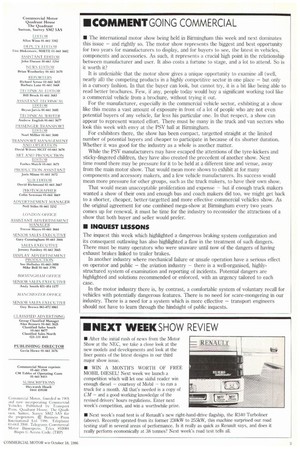• The international motor show being held in Birmingham this
Page 5

If you've noticed an error in this article please click here to report it so we can fix it.
week and next dominates this issue — and rightly so. The motor show represents the biggest and best opportunity for two years for manufacturers to display, and for buyers to see, the latest in vehicles, components and accessories. As such, it represents a crucial high point in the relationship between manufacturer and user. It also costs a fortune to stage, and a lot to attend. So is it worth it?
It is undeniable that the motor show gives a unique opportunity to examine all (well, nearly all) the competing products in a highly competitive sector in one place — but only in a cursory fashion. In that the buyer can look, but cannot try, it is a bit like being able to read better brochures. Few, if any, people today would buy a significant working tool like a commercial vehicle from a brochure, without trying it out.
For the manufacturer, especially in the commercial vehicle sector, exhibiting at a show like this means a vast amount of exposure in front of a lot of people who are not even potential buyers of any vehicle, far less his particular one. In that respect, a show can appear to represent wasted effort. There must be many in the truck and van sectors who look this week with envy at the PSV hall at Birmingham.
For exhibitors there, the show has been compact, targetted straight at the limited number of potential buyers and cheaper to participate in because of its shorter duration. Whether it was good for the industry as a whole is another matter.
While the PSV manufacturers may have escaped the attentions of the tyre-kickers and sticky-fingered children, they have also created the precedent of another show. Next time round there may be pressure for it to be held at a different time and venue, away from the main motor show. That would mean more shows to exhibit at for many components and accessory makers, and a few vehicle manufacturers. Its success would mean more pressure for other groups, such as the truck makers, to have their own show.
That would mean unacceptable proliferation and expense — but if enough truck makers wanted a show of their own and enough bus and coach makers did too, we might get back to a shorter, cheaper, better-targetted and more effective commercial vehicles show. As the original agreement for one combined mega-show at Birmingham every two years comes up for renewal, it must be time for the industry to reconsider the attractions of a show that both buyer and seller would prefer.
III INQUEST LESSONS The inquest this week which highlighted a dangerous braking system configuration and its consequent outlawing has also highlighted a flaw in the treatment of such dangers. There must be many operators who were unaware until now of the dangers of having exhaust brakes linked to trailer brakes.
In another industry where mechanical failure or unsafe operation have a serious effect on operator and public — the aviation industry — there is a well-organised, highlystructured system of examination and reporting of incidents. Potential dangers are highlighted and solutions recommended or enforced, with an urgency tailored to each case.
In the motor industry there is, by contrast, a comfortable system of voluntary recall for vehicles with potentially dangerous features. There is no need for scare-mongering in our industry. There is a need for a system which is more effective — transport engineers should not have to learn through the hindsight of public inquests.
































































































































































































